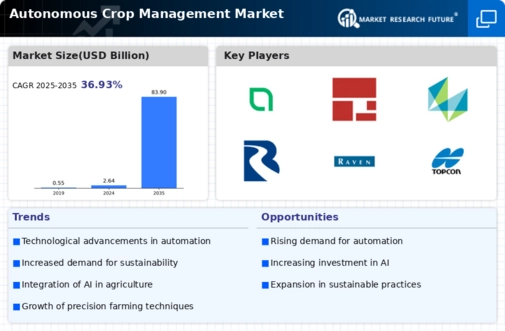Market Growth Projections
The Global Autonomous Crop Management Market Industry is projected to experience substantial growth, with estimates indicating a rise from 2.64 USD Billion in 2024 to 83.9 USD Billion by 2035. This trajectory reflects a compound annual growth rate (CAGR) of 36.95% from 2025 to 2035, highlighting the increasing adoption of autonomous technologies in agriculture. The market's expansion is driven by various factors, including technological advancements, rising food demand, and sustainability initiatives. As stakeholders recognize the potential of autonomous crop management solutions, investment and innovation in this sector are likely to accelerate, shaping the future of agriculture.
Government Initiatives and Support
Government initiatives and support play a crucial role in the Global Autonomous Crop Management Market Industry. Many governments are implementing policies that encourage the adoption of advanced agricultural technologies. For example, subsidies for precision farming equipment and funding for research into autonomous systems are becoming more common. These initiatives not only enhance the financial viability of adopting such technologies but also promote innovation within the sector. As a result, the market is poised for substantial growth, with an expected increase in investment and development of autonomous solutions that align with national agricultural goals.
Increasing Demand for Food Security
The Global Autonomous Crop Management Market Industry is significantly influenced by the increasing demand for food security. As the global population continues to rise, the pressure on agricultural systems intensifies. Autonomous crop management solutions offer a viable response to this challenge by enhancing productivity and reducing waste. For example, automated irrigation systems can optimize water usage, which is crucial in regions facing water scarcity. This trend is expected to contribute to the market's expansion, with projections indicating a growth to 83.9 USD Billion by 2035, underscoring the urgency of adopting innovative agricultural technologies.
Rising Labor Costs and Labor Shortages
Rising labor costs and labor shortages are significant factors driving the Global Autonomous Crop Management Market Industry. As agricultural labor becomes increasingly scarce and expensive, farmers are turning to automation as a solution. Autonomous machinery can perform tasks such as planting, harvesting, and monitoring crops with minimal human intervention, thereby reducing reliance on labor. This trend is particularly evident in regions where labor shortages are acute. The shift towards automation not only addresses labor challenges but also enhances operational efficiency, positioning the market for robust growth in the coming years.
Sustainability and Environmental Concerns
Sustainability and environmental concerns are pivotal drivers of the Global Autonomous Crop Management Market Industry. Farmers are increasingly adopting practices that minimize environmental impact, such as precision agriculture, which reduces chemical usage and promotes soil health. Autonomous systems facilitate these practices by providing data-driven insights that help farmers make informed decisions. For instance, the use of sensors and drones allows for targeted application of fertilizers and pesticides, thereby reducing runoff and pollution. This shift towards sustainable farming practices is likely to bolster market growth as stakeholders recognize the long-term benefits of environmentally friendly agriculture.
Technological Advancements in Agriculture
The Global Autonomous Crop Management Market Industry is experiencing rapid growth due to technological advancements in agricultural practices. Innovations such as precision farming, drones, and automated machinery are revolutionizing crop management. For instance, the integration of AI and machine learning in farming equipment allows for real-time data analysis, optimizing resource use and enhancing yield. As a result, the market is projected to reach 2.64 USD Billion in 2024, with a remarkable CAGR of 36.95% anticipated from 2025 to 2035. This growth reflects a broader trend towards automation in agriculture, driven by the need for efficiency and sustainability.










